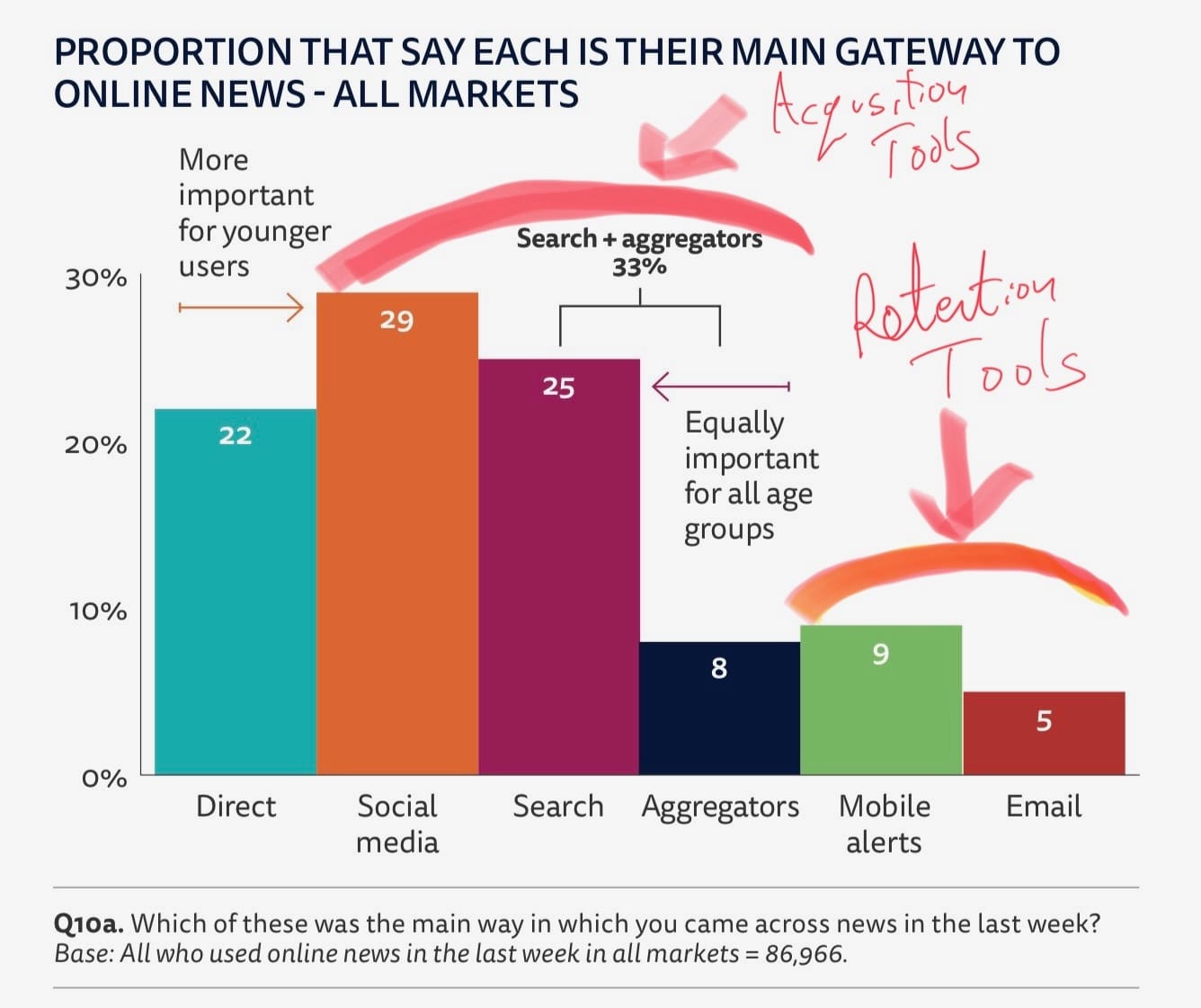
Finding news audiences in the social media shift
In the first of a series of pieces inspired by the 2024 Reuters Institute Digital News Report, we look at the dramatic changes happening in social and what they mean for you.
Some years ago, one of my former students explained the reason she’d moved from an audience-related job at a national newspaper with no little frustration. Whenever search or social algorithms shifted, she said, the higher-ups rejected any attempt to experiment, just insisted that the team did what they’d always done — only harder.
It sounds like a joke, but it isn’t, both because it’s both true and because too much of the industry is still trapped in this thinking. If they’re not, then they’re trapped into thinking of things like search and social as necessary evils, to be run away from as soon as things get hard. But, as the latest Reuters Institute Digital News Report makes clear, that’s not an option. And it all comes down to my absolute favourite word: attention.
We need to know where our audience’s attention is and how we can win our fair share of it. I’ve often described the dirty secret of all audience work is that it can be summed up thus: it’s the process of matching journalists’ time with readers’ attention in a way that profits both. And that’s never been more important than now.
Where’s the audience for news coming from?
Let’s have a look at this helpful graph from the report:
22% say that their main gateway to news is direct to the new site. Great. Those are the most loyal readers. We have them. They’re the core news audience. Let’s love them and treat them well. But we also need to grow.
For everyone else, there’s a gateway at work. They come to news indirectly. Social remains the biggest gateway, despite the shifts in algorithms and the general sense of doom and gloom around the relationship between news and social media. That’s, in part, because there’s a format shift at work, which I’ll explore in another article. That means that social still matters, a theme I’ll come back to shortly.
Aggregators are the new kids on the block (relatively speaking). I’d say they were under-discussed online, but are typically mentioned as significant by guest speakers we have in for my audience students. And search is the good, long-term performer that we’re all worried about because of… AI. (Seven pars in before I mentioned AI — not bad.)
Why do I say aggregators are under-discussed? Well, compare them to newsletters in terms of the graph above. Yup, aggregators are more important as a gateway to news than newsletters, but I bet you’ve read a lot more about email than you have apps like Apple News and its ilk.
Yet, aggregators are a growth business:
It is also worth noting the increasing success of mobile aggregators in some countries, many of which are increasingly powered by AI. In the United States, News Break (9%), which was founded by a Chinese tech veteran, has been growing fast with a similar market share to market leader Apple News (11%). In Asian markets, multiple aggregator apps and portals play important gateway and consumption roles, with AI features typically driving ever greater levels of personalisation.
Aggregator management and optimisation is a key new skill for the industry, and one I need to spend more time on for next year’s audience strategy cohort.
Acquisition versus retention tools
However, my email/aggregators comparison might not be entirely fair. Email and mobile alerts are, fundamentally, in a different category from one another. Here’s my own, highly professional, annotations on the graph:

Newsletters and push notifications are essentially loyalty-building tools: they deepen the relationship with existing readers. Vanishingly few readers are going to come into your orbit for the first time through these tools. (There are rare exceptions: an alert from an aggregator, for example, but that’s really in the aggregator category. And, yes, a forwarded email can lead to initial sampling. But these are small in volume.)
What we need to concentrate on is the 62% of people who are getting their news through the acquisition category. These are the people whose attention is on social, in search, and in aggregators. This is where all your new audience is going to come from. That’s why the “death of social” articles are so very deeply misguided. As long as people are giving their attention to social platforms, we will need to find ways of:
- Building audiences on these platforms
- Finding ways of bringing those audiences into unmediated relationships
What do I mean by unmediated? Bringing them into direct relationship, via newsletters, podcasts, push notifications, or even just by helping them develop a habit of visiting the site.
Let’s concentrate down on social today because search is changing less fast, albeit with one, huge and AI-shaped caveat.
The new face of Social
If you’ll excuse me a second anecdote, many years ago I attended a conference in Exeter, at about the time that Google launched Google+. While there were some people from journalism there, they were in the minority. It was, largely, wall-to-wall marketeers. And they were panicking. They’d been taught how to “do” Facebook and Twitter, but this new platform was, well, new. There was no best practice, or online guides to success. And that terrified them.
That’s where we all are now. The social duopoly is long dead. Another wee graph from the report:
With the slow collapse in the use of Facebook for news, we’re now in something of a battleground, with multiple social platforms attracting news-based attention (in some cases, against their own desires…). (I’m curious about the lack of LinkedIn in there, given how many newsrooms are finding it an increasing source of traffic.) As the report puts it:
News use across online platforms is fragmenting, with six networks now reaching at least 10% of our respondents, compared with just two a decade ago. YouTube is used for news by almost a third (31%) of our global sample each week, WhatsApp by around a fifth (21%), while TikTok (13%) has overtaken Twitter (10%), now rebranded X, for the first time.
If you’re reading that and despairing because you have no idea how you’re going to manage six social networks, boy do I have some great news for you. Unless you’re leading audience for a national or international newspaper (and hello the handful of you who are reading this!), that’s not going to be your problem.
Navigating the social platform diaspora
No, instead, it’s about discerning which platforms your audience(s) use for the sorts of journalism they’re interested in. That terror that grabbed the marketeers in the face of Google+ is back, and more realistic than before. We are in the process of a social media diaspora, where different communities exit the big older platforms, and reform elsewhere. That can be in unexpected and unpredictable places.
For example, Threads and Mastodon are both showing as sub-1% right now. That’s not to write them off — that 1% might really matter if it’s where your community has chosen to head. The report, by its very nature, is looking at the broader scale of “news”, and often the more mainstream idea of national/international news. The more niche your title — or desk — is, the more work you’re going to have to put in figuring out how to reach people.
But you have no choice. To ignore social now is to ignore where 29% of the potential audience put their attention first. It is, and remains, a core top end of the audience acquisition play.
Audience > traffic
Let’s say that again, but with a bit more emphasis: it’s a core top end of the audience acquisition play. Not the traffic acquisition play, the audience one. The era of easy traffic from social is gone. Sorry. But it is. The existing platforms are massively down-ranking the organic reach of links:
Industry data show that the combined effect of these changes was to reduce traffic referrals from Facebook to publishers by 48% last year and from X by 27%.4
Again, you’re not looking for traffic specifically (although we’ll take any we can get, obviously), we’re looking to win attention that we can then convert into relationship, in a concrete form where we are no longer dependent on the platform where we started the relationship to continue it. All the social vanity metrics in the world mean nothing, if you can’t convert a significant chunk of those people into a loyal audience.
That job has got harder, and more complex, as the platforms and formats diversify. On one level, that’s really exciting because what a remarkable gift of permission to experiment that is. On another level, it’s terrifying because what if those experiments don’t bear audience fruit?
Surviving the social shift
I’d take issue with this statement in the report:
Our data suggest we are now at the beginning of a technology shift which is bringing a new wave of innovation to the platform environment, presenting challenges for incumbent technology companies, the news industry, and for society.
I think we’re well into that shift, but that the impact of it on news patterns is starting to be felt. The core technical changes underlying this move have been in place for half a decade or more, even if some are now accelerating (like AI).
The core message, though, is correct. There is no going back. The shift is underway, and is established enough that it won’t reverse. Social isn’t dying, it’s regenerating. Even if some countries ban TikTok, for example, the format will endure on other platforms. And so, we have to adapt, too. We’re entering a period of experimentation, both with platforms — which are right for your audience? — and with formats.
But we can’t afford to experiment without an eye to the core goal: of bringing our core audience into direct relationship with us. The better your newsletter, direct or push figures are doing against the baseline in the report, the stronger your audience relationships are. If you’re below the baselines, well, I’d get working on that pretty damn fast.
Sign up for e-mail updates
Join the newsletter to receive the latest posts in your inbox.










